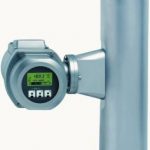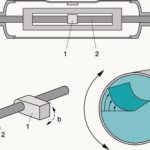Viscosity is important in most processes where mass flow is measured. It therefore makes sense for both measurements to be integrated into one device. The Proline Promass 83 I Series flowmeters combine viscosity determination with simultaneous mass flow, density and temperature measurements. One user of these flowmeters is Ciba Spezialitätenchemie Pfersee GmbH, where the Promass 83 I measures the inline viscosity of a polymerisation reaction for the production of polyamines.
Daniel Winter, Ellen-Christine Reiff
The viscosity of a fluid is a crucial parameter in many production processes. It essentially describes product characteristics such as consistency or pourability. These values are ultimately used to define the quality or processability of a wide range of products. This applies to foodstuffs in exactly the same way as it does to adhesives, paints, sludges or cosmetic products. At the same time, the viscosity of the medium is often an important control value which can, for example, highlight problems in the process. If measured directly inline, the operator can react immediately to critical values, thereby possibly preventing entire batches from being destroyed. Measuring systems which work according to the Coriolis principle are an excellent choice in this regard.
Anyone who up to now has had to measure viscosity directly inline has usually relied on what are known as inline viscometers. Although the initial purchase cost of these devices is very low, they require a high degree of maintenance due to the numerous moving parts involved. In addition, the devices must be recalibrated each time one of the wear-prone components is replaced, which in turn pushes up the follow-up costs for many applications. Often, the only alternative has been to measure auxiliary variables such as density or conductivity in order to obtain information on the product characteristic. This requires additional measuring points and relatively intensive maintenance. Alternatively, the viscosity can be measured in a laboratory. As the process inevitably continues to run during the time from when the sample is taken to when the analysis is completed, this means that trends or a deterioration in the prod-uct quality frequently fail to be identified until it is too late.
Multifunctional devices
Viscosity is important in most processes where mass flow is measured. It therefore makes sense for both measurements to be integrated into one device. This is why Endress+Hauser now offers the Proline Promass 83 I Series flowmeters with integrated viscosity measurement. The measuring system, featuring a straight measuring tube made of titanium, is available with a nominal diameter of DN 8 to DN 50, and its design guarantees minimum pressure loss, gentle treatment of the medium to be measured and easy cleaning. The patented Torsion Mode Balance (TMB) system makes it immune to vibrations and ensures high zero point stability. Coriolis mass flowmeters have been used for roughly two decades in many liquid and gas applications. Over the years they have made a name for themselves as robust, reliable and accurate field devices in a wide range of industries, from food and beverages to chemicals, petrochemicals and pharmaceuticals. They measure the mass flow directly, while simultaneously recording the density and temperature of the medium. In addition, the viscosity of the liquid can be determined independently using a single-tube system.
Torsional movement in the tube
Measuring viscosity involves using the torsional movements in the straight measuring tube that are caused by the pendulum attached to it. The measuring tube is decoupled from the piping with the pendulum, which is mounted as part of the TMB system and serves as a counterweight. The reason for this is that the tube oscillates counterphase to the pendulum. However, the movement of the pendulum simultaneously induces a torsional movement in the tube. As a result of this combined bending/torsional oscillation, oscillation compensation is significantly increased, and the torsion itself is used to measure the viscosity.
The principle is basically the same as when turning a glass of juice in your hand. The torsional oscillations excite the fluid layers in the tube i.e. they are subjected to shearing. Depending on the viscosity of the medium, a varying number of layers dampens the measuring tube oscillations in the process. As the shear force on the inside of the tube is a function of the shear rate and the viscosity, a specific driving torque is essential for a specific shear force in order to maintain the oscillation. In the example with the glass of juice, you have to turn the glass sufficiently quickly and vigorously. In the same way, in the case of the mass flowmeter, the viscosity is calculated on the basis of the energy required to maintain the measuring tube oscillation. The necessary electronics and software are implemented in the switching unit. Other options can be integrated here too if need be, e.g. concentration measurement using the integrated density measurement.
Suitable for Newtonian and non-Newtonian fluids
However, not all fluids for which inline viscosity measurement is useful behave in the same way. The viscosity of Newtonian fluids is independent of the shear rate, while in the case of non-Newtonian fluids the viscosity changes with the shear rate. However, the Coriolis method of measurement works for both types of viscosity. The principle with Newtonian liquids is simple: Promass I is calibrated with Newtonian fluids and measures their dynamic viscosity. The inline measurement achieves an accuracy of over ±5 % here. This more than suffices to allow trends to be identified or, for example, to assess the pourability of a medium.
The evaluation of the measurement results is more complicated with non-Newtonian fluids. In this case, comparisons of an inline measurement with values obtained in the laboratory are highly complex because the viscosity is dependent on the shear rate. However, the viscosity of these media can also be measured using Promass 83 I with an excellent repeatability of ±0.5 %. As it is reproducibility and not absolute accuracy which is key in conducting trend analyses or in ascertaining relative changes, Promass I is also suitable for non-Newtonian media.
Production of polyamines
Ciba Spezialitätenchemie Pfersee GmbH in Langweid, with over 400 employees, develops, produces and distributes products for textile finishing and for water and paper treatment. At the Langweid facility, polyamines are manufactured using a polymerisation procedure. At process temperatures up to 90 °C, the viscosity of the product rises continuously during the production process. Once the target viscosity has been reached (this can be up to 5000 mPas depending on the product), the reaction is ended through the addition of a blocking agent. This constitutes an extremely important step in the process, because if the target viscosity is exceeded the product becomes gel-like and can only be removed with great difficulty and at great expense. Furthermore, damage may occur to the stirring apparatus.
In the past, samples of the medium were taken and assessed on a cyclical basis in order to monitor its viscosity. In doing so, there was a very high risk that the viscosity might exceed the desired range between samples. In addition to mass flow measurement, Proline Promass I is used in this process for fully automatic measurement of viscosity. The viscosity is quickly and accurately recorded directly inline on a continuous basis and sent to the control centre via 4…20 mA. The target viscosity is set there for each product. As soon as this viscosity is reached, the addition of the blocking agent is triggered. Proline Promass 83 I with viscosity measurement guarantees optimum monitoring of the product and, thanks to its reliable viscosity measurement, minimises the operational and additional costs which could arise if the target viscosity were exceeded.
Hall 7, Booth F29
cpp 435
Compact and reliable
For direct measurement of mass flow according to the Coriolis principle, harmonic oscillations are first induced in a tube using a defined frequency. A liquid particle which now flows into the oscillating tube experiences a lateral acceleration. Due to its inertia, it dampens the oscillation on the inlet side at the start of the tube. At the end of the tube, in other words at the outlet, it releases the energy it has absorbed. The oscillation in the tube increases as a result. A phase difference arises in the tube oscillation which can now be measured using highly sensitive sensors. It is directly proportional to the mass flow and independent of other values such as density, temperature or pressure. Compared to measuring volume first and then density additionally, this measurement process is therefore considerably more compact and, most importantly, more accurate.
How density is measured: The measuring tubes are always excited at their resonance frequency. As soon as the density of the liquid in the measuring tube changes, the exciting frequency adjusts automatically. The resonance frequency is therefore a function of the density of the medium. Owing to this dependence, a density signal can be obtained using a microprocessor. To compensate from a mathematical point of view for thermal influences, the temperature of the measuring tube is also recorded. This corresponds to the process temperature and is likewise available as an output signal.
More about Promass 83 I
Ciba Spezialitätenchemie Pfersee
Share:








